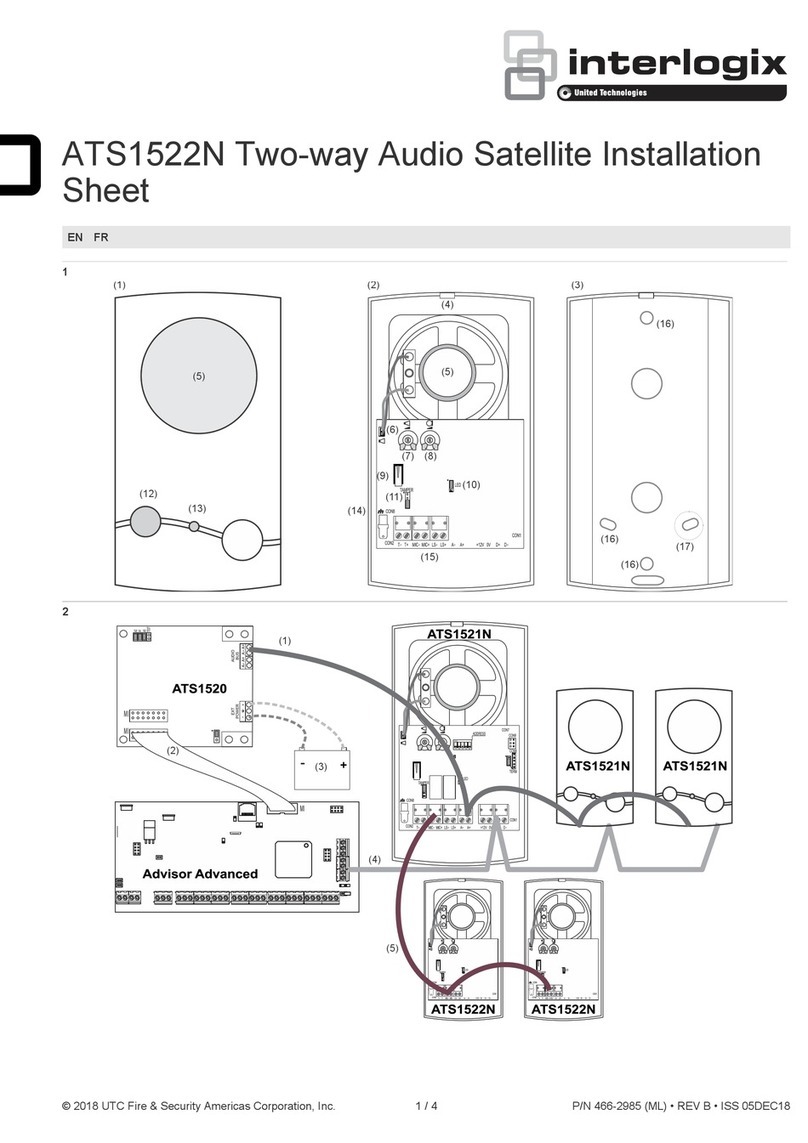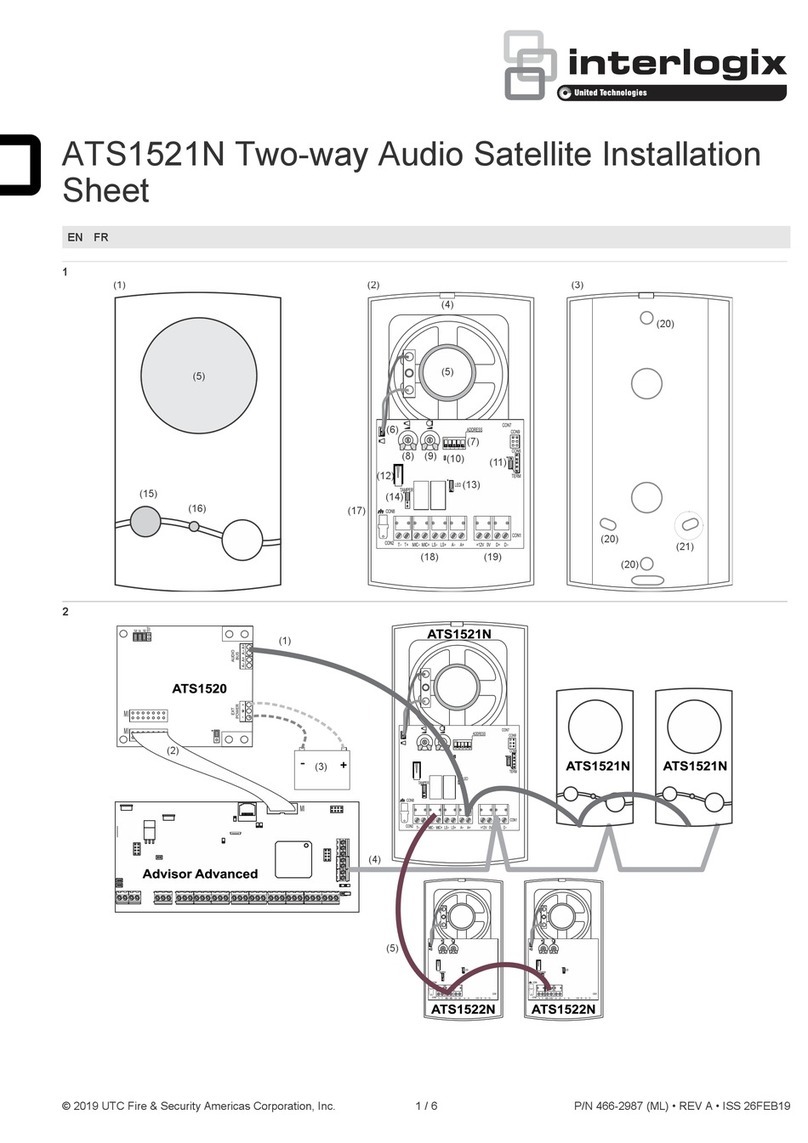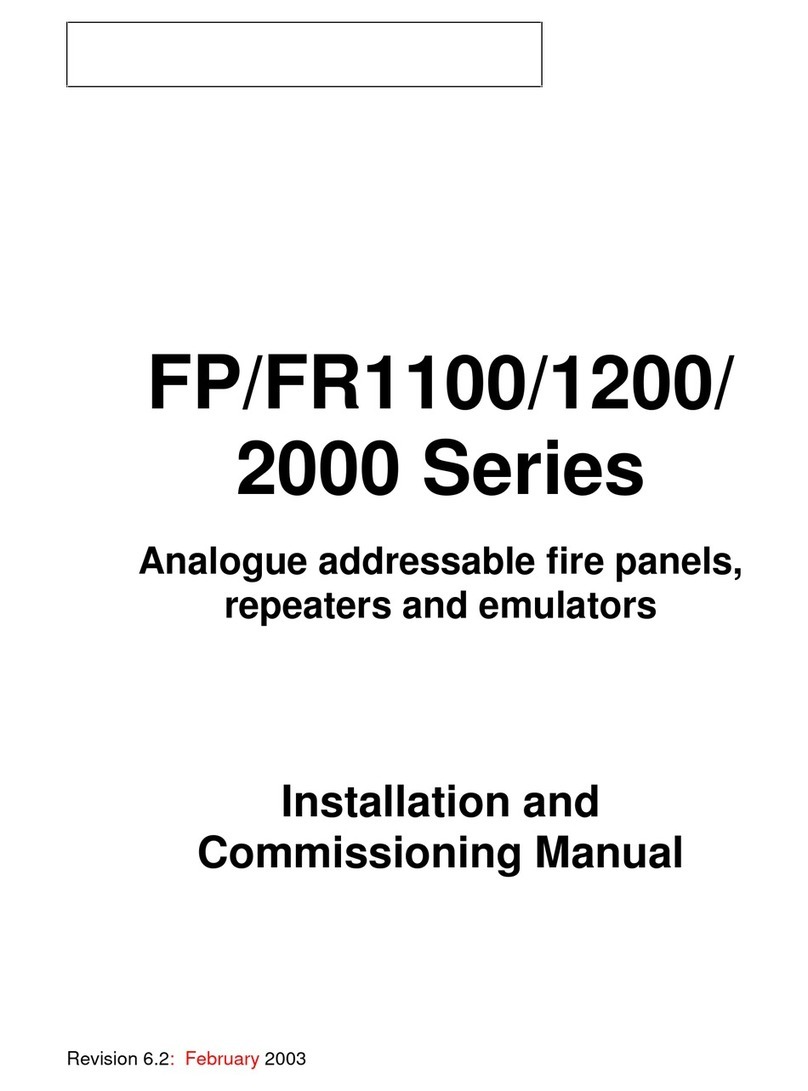
2ESL/ITIWireless Smoke Sensors
and hallways not protected by the required smoke
alarms/detectors. The installation of smoke alarms/
detectors in kitchens, attics (finished or unfinished), or
garages is not normally recommended, as these locations
occasionally experience conditions that can result in
improper operation.
Regulations pertaining to smoke alarm/detector
installations vary from state to state. For more information,
contact your local fire department or local authority
having jurisdiction.
GDO NOT mount a smoke alarm to a drop ceiling tile;
mount it to a metal runner.
GMount all smoke alarms within 100 feet of the panel.
GInstall a minimum of two smoke alarms in any house
hold, no matter how small it is.
GPut a smoke alarm in the hallway outside of every
bedroomarea.Aminimum of twosmokealarmsare
required in homes with two bedroom areas.
GPut a smoke alarm on every level of a multi-level
residence.
GInstall basement alarms on the ceiling as close to the
center of the room as possible. If this is not practical,
install it on the ceiling no closer than 4 inches (10 cm)
fromany wall or corner.
GIf ceiling mounting is not practical, install on an
inside wall between 4 and 6 inches (10 and 15 cm) from
the ceiling.
GPut smoke alarms at both ends of a bedroom hallway
if the hallway is more than 30 feet (9 meters) long.
Large rooms over 900 square feet require more than a
single sensor.
GAreas with rough ceilings or short, transom-type walls
coming down from the ceiling require additional
smokealarms.
GInstall second-floor smoke alarms on the ceiling at the
top of the first-to-second floor stairwell. be sure no
door or other obstruction blocks the path of smoke to
the unit.
GIn rooms with sloped, peaked, or gabled ceilings, install
smoke alarms 3 feet (0.9 meter) measured down on the
slant from the highest point of the ceiling (see Figure 5).
In addition to smoke alarms/detectors outside of the sleeping
areas, Chapter 8 requires the installation of a smoke alarm/
detector on each additional story of the family living unit,
including the basement. These installations are shown in
Figure 3. The living area smoke alarm/detector should be
installed in the living room or near the stairway to the upper
level, or in both locations. The basement smoke alarm/
detector should be installed in close proximity to the stairway
leading to the floor above. Where installed on an open-joist
ceiling, the alarm/detector should be positioned relative to
the stairway so as to intercept smoke coming from a fire in
the basement before the smoke enters the stairway.
NFPA72,A-8-1.2.1.b Where to Locate the Required Smoke
Alarms/Detectors in New Construction. All of the smoke
alarms/detectors specified inA-8-1.2.1.a for existing construc-
tion are required and, in addition, a smoke detector is
required in each bedroom.
NFPA72,A-8-1.2.1.c Are More Smoke Alarms/Detectors
Desirable? The required number of smoke alarms/detectors
might not provide reliable early warning protection for those
areas separated by a door from the areas protected by the
required smoke alarms/detectors. For this reason, it is
recommended that the householder consider the use of
additional smoke alarms/detectors for those areas for
increased protection. The additional areas include the
basement, bedrooms, dining room, furnace room, utility room,
LIVING ROOM
KITCHEN
BEDROOM
BEDROOM
BEDROOM
TV ROOM
DINING ROOM
BATHROOM
SMOKE ALARMS/DETECTORS
FOR MINIMUM PROTECTION
SMOKE ALARMS/DETECTORS
FOR ADDITIONAL PROTECTION
HEAT ACTIVATED ALARMS/DETECTORS
KITCHEN
BEDROOM
LIVING
ROOM
GARAGE
BASEMENT
BEDROOM
BEDROOM
SMOKE ALARMS/DETECTORS FOR MINIMUM PROTECTION
SMOKE ALARMS/DETECTORS FOR ADDITIONAL PROTECTIO
HEAT ACTIVATED ALARMS/DETECTORS
Figure 2. Family units with more than one
bedroom area.
Figure 3. Multilevel family units.
Figure 4. Smoke alarm mounting locations.
BEST LOCATION
ACCEPTABLE LOCATION
DEAD AIR
SPACE BEST IN CENTER
OF CEILING
NO CLOSER THAN 4
"
(10 cm)
FROM SIDE WALL
MOUNT ON WALL
AT LEAST 4
"
(10 cm)
FROM CEILING
NO MORE
THAN 6
"
(15 cm)
FROM CEILING
Important !






























